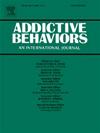Shifts in motivation to quit cigarette smoking associated with IQOS use
IF 3.7
2区 医学
Q1 PSYCHOLOGY, CLINICAL
引用次数: 0
Abstract
Introduction
IQOS, a heated tobacco product (HTP), is among a growing number of noncombustible nicotine delivery alternatives marketed to people who smoke combustible cigarettes and are interested in less harmful alternatives. Little is known regarding whether IQOS use and IQOS-associated effects impact motivation to quit cigarette smoking.
Methods
Non-treatment-seeking adult daily smokers (n = 87) completed a within-subjects study consisting of a baseline ad-lib smoking period (days 1–5), two laboratory visits (days 6–7) involving IQOS exposure, and a two-week period where participants were instructed to switch from smoking cigarettes to using IQOS (days 8–21). Motivation to quit smoking was measured on days 1 and 22.
Results
A generalized linear model revealed a significant increase in motivation to quit smoking across the 14-day switch phase with an increase of 1.47 ladder steps (Δ=1.47, sd = 1.98, t(86) = 6.92, p < 0.0001), increasing from 5.30 to 6.80. Candidate predictors were identified through a stepwise selection procedure, which resulted in a final model with two predictors, the standardized HeatStick substitution rate (b = 0.54, (CI95% 0.13–0.95), p = 0.01) and standardized relative risk perception score (b = 0.45, (CI95% 0.04–0.85) p = 0.03),
Conclusions
Among those uninterested in quitting cigarette smoking within the next month, IQOS use was associated with increased motivation to quit. Motivation to quit smoking may not be a necessary prerequisite for promoting smoking behavior change but rather bolstered by smoking behavior change in the context of HTP use. Greater perceptions of risk reduction may ultimately aid the transition from combustible to noncombustible tobacco products.
与使用 IQOS 有关的戒烟动机转变
导言IQOS是一种加热烟草制品(HTP),是越来越多的非燃烧尼古丁递送替代品之一,其销售对象是吸可燃卷烟并对危害较小的替代品感兴趣的人。方法非寻求治疗的成年日常吸烟者(n = 87)完成了一项受试者内研究,该研究包括基线广告吸烟期(第 1-5 天)、两次实验室访问(第 6-7 天)(涉及 IQOS 暴露),以及指导参与者从吸烟转为使用 IQOS 的两周时间(第 8-21 天)。结果一个广义线性模型显示,戒烟动机在14天的转换阶段显著增加,增加了1.47个阶梯(Δ=1.47, sd = 1.98, t(86) = 6.92, p <0.0001),从5.30增加到6.80。通过逐步选择程序确定了候选预测因子,最终建立了一个包含两个预测因子的模型,即标准化热棒替代率(b = 0.54, (CI95% 0.13-0.95), p = 0.01)和标准化相对风险感知评分(b = 0.45, (CI95% 0.04-0.85) p = 0.03)。戒烟动机可能并不是促进吸烟行为改变的必要前提,在使用HTP的情况下,吸烟行为的改变反而会促进戒烟动机。对降低风险的更多认识可能最终有助于从可燃烟草产品向非可燃烟草产品的过渡。
本文章由计算机程序翻译,如有差异,请以英文原文为准。
求助全文
约1分钟内获得全文
求助全文
来源期刊

Addictive behaviors
医学-药物滥用
CiteScore
8.40
自引率
4.50%
发文量
283
审稿时长
46 days
期刊介绍:
Addictive Behaviors is an international peer-reviewed journal publishing high quality human research on addictive behaviors and disorders since 1975. The journal accepts submissions of full-length papers and short communications on substance-related addictions such as the abuse of alcohol, drugs and nicotine, and behavioral addictions involving gambling and technology. We primarily publish behavioral and psychosocial research but our articles span the fields of psychology, sociology, psychiatry, epidemiology, social policy, medicine, pharmacology and neuroscience. While theoretical orientations are diverse, the emphasis of the journal is primarily empirical. That is, sound experimental design combined with valid, reliable assessment and evaluation procedures are a requisite for acceptance. However, innovative and empirically oriented case studies that might encourage new lines of inquiry are accepted as well. Studies that clearly contribute to current knowledge of etiology, prevention, social policy or treatment are given priority. Scholarly commentaries on topical issues, systematic reviews, and mini reviews are encouraged. We especially welcome multimedia papers that incorporate video or audio components to better display methodology or findings.
Studies can also be submitted to Addictive Behaviors? companion title, the open access journal Addictive Behaviors Reports, which has a particular interest in ''non-traditional'', innovative and empirically-oriented research such as negative/null data papers, replication studies, case reports on novel treatments, and cross-cultural research.
 求助内容:
求助内容: 应助结果提醒方式:
应助结果提醒方式:


